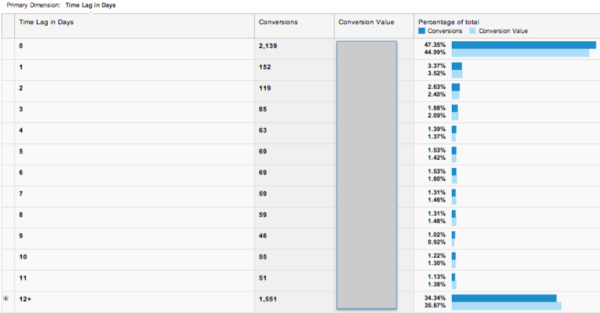Using Time To Stop Undervaluing Channel Performance
Standard channel performance analysis makes the assumption that a click from all channels behaves the same way. Picture your weekly performance report – in a given week you observe x clicks and y conversions coming from a given channel (eg PPC, Organic search, Display, Remarketing Facebook, etc). If one channel looks better than the others […]
Standard channel performance analysis makes the assumption that a click from all channels behaves the same way. Picture your weekly performance report – in a given week you observe x clicks and y conversions coming from a given channel (eg PPC, Organic search, Display, Remarketing Facebook, etc).
If one channel looks better than the others you shift budgets or bids accordingly. It’s standard practice but is it the complete picture?
What if all channels aren’t equal? A click from one channel might be worth more than a click from another channel, especially over longer periods of time. At face value this seems logical and if you dig in, it becomes clear that time skews our ability to determine the true value of a click and expected performance over a static period of time.
As a result, we need to factor time into the equation in order to understand short term versus long term channel performance. The results are not only surprising, but may completely change the way you manage performance marketing channels.
For starters, let’s look at a Google Analytics 30 day time lag report for all channels (Available in multi-channel funnels reporting section):
Different business will observe different patterns. I’ve chosen a particular set of data which highlights the latency in conversion to make my point more clear. The graph shows that roughly 46% of conversions occur within the first 7 days. That means 54% of conversions in this analysis occur between day 8 and 30 following the users’ first entry.
Let’s go back to the channel performance report and look at one channel, let’s say PPC, over a 12 week period:
Ad servers (ex AdWords, AdCenter, DoubleClick, etc) generally attribute conversions to the day of click, so over time conversion numbers continue to look better and better. The time lag report makes sense of the rate at which latent conversions come in.
Google Analytics also offers a similar attribution process through multi-channel funnels. It’s worth noting that default Google Analytics reporting leverages day of conversion attribution – by that I mean that revenue is associated with the day that the purchase was made.
But via multi-channel reports, we can create a conversion segment to display revenue attributed to the first interaction, in this case, Paid Advertising.
Hopefully you see where I’m going with this by now. A one-week snapshot of performance by channel attributing to first interaction or day of click, while ideal for optimization purposes, will always make things look worse that they really are in the short term.
It’s easy to use day of conversion attribution reporting to make things look better but you’re most likely not taking into account the true effectiveness of marketing dollars spent due to latency of conversions.
For example, if you push for more volume this week and report with day of conversions attribution then you will most likely show relatively poor performance as conversions volume recorded this week is commensurate with marketing dollars spent in previous weeks.
Being patient and waiting out the cookie window might just show that what was initially perceived as poor performance was in fact a highly productive and efficient.
By running channel specific time lag analyses, we can build models to predict the latent efficiency on weekly data. Incorporating these models / multipliers into reporting we can effectively manage expectations of bosses or clients so they see the benefits of pushing for more volume rather than rushing to judgment during the sensitive period of time pushing for volume and reaping the rewards of additional conversions.
Hindsight is always 20/20. Forcing marketing data that operates with latency into a one week view will never tell the whole story. Leverage existing data to build a similar model and educate your team on your company’s normal conversion behavior / time lag to garner support to grow your marketing channel.
Contributing authors are invited to create content for Search Engine Land and are chosen for their expertise and contribution to the search community. Our contributors work under the oversight of the editorial staff and contributions are checked for quality and relevance to our readers. The opinions they express are their own.
Related stories



